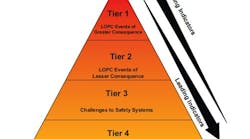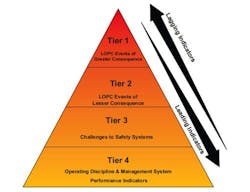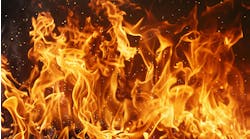Process Safety: Understand the Changes in API RP 754
In 2010, the American Petroleum Institute (API) issued “Recommended Practice (RP) 754: Process Safety Performance Indicators for the Refining and Petrochemical Industries” [1]. This standard has gained broad acceptance and use not only by the refining and petrochemical sectors in the United States but also by other sectors of the energy industry and by other process industries in the U.S. and around the globe.
The drafting committee recognized the entirely new nature of this standard and believed its use would lead to valuable insights that a second edition should reflect. So, the standard was re-opened in August 2013 after two complete years of data collection, and the committee considered a variety of revisions. Here’s a guide to changes in the second edition, which was published in April 2016 [2].
From the very beginning, committee members agreed that the standard is not broken, as demonstrated by its rapid voluntary adoption by many organizations and companies around the world. However, many ideas for potential improvements were suggested, including expansion of the standard for application to petroleum pipeline and terminal operations, retail service stations, and oil and gas drilling and production operations. These enhancements appear in the second edition; individual annexes define appropriate changes to the applicability and definitions sections of the RP tailored to those specific operations. Other recommendations for improvement spanned the desire for greater clarity in application of the standard to the many facets and nuances of process safety, additional guidance regarding identification and use of Tier 3 and 4 (Figure 1) leading indicators, more examples of process safety event (PSE) tiering to address questions brought forward in quarterly RP 754 webinars hosted by the API and American Fuels and Petrochemical Manufacturers (AFPM), and a few targeted changes to the criteria used to define Tier 1 and 2 PSEs.
Figure 1. Incidents fall into four tiers, topped by highest impact, lowest frequency events. Note: LOPC = loss of primary containment.
Key Changes Considered
The three most-complex proposals for change subjected to formal balloting were:
1. Increasing the direct cost damage threshold for fires and explosions for Tier 1 from $25,000 to $100,000. This change was approved. Fires and explosions with direct cost damages between $25,000 and $100,000 move to Tier 2. The $2,500 threshold value for Tier 2 fires and explosions remains unchanged — so the total of events captured in Tier 1 and Tier 2 stays the same. The committee believes that changing the threshold to $100,000 places the significance of this category of PSE more on par with the other criteria for Tier 1.
[callToAction ]
2. Use of the hazard class designations from the globally harmonized system for classification and labeling (GHS) to designate threshold release categories (TRCs) for tiering of releases by quantity released. No proposed change was more thoroughly studied or actively discussed than this one. Many of the existing TRC criteria (e.g., Tier 1 TRC 2, 3 and 4 for toxic inhalation hazards; TRC 5, 6 and 7 for flammable gases and liquids; and TRC 6 and 7 for skin corrosion) already are based upon the same criteria used in GHS. Criteria for other health hazards such as oral ingestion toxicity, respiratory and skin sensitizers (Class 3.4), germ cell mutagenicity (3.5), carcinogenicity (3.6), reproductive toxicity (3.7), specific target organ toxicity for single and repeated exposures (3.8 and 3.9), and aspiration (3.10), as well as environmental hazards to the aquatic environment (4.1) and the ozone layer (4.2) proved more difficult. A key feature of the criteria for delineating thresholds for inhalation toxicity, flammability of gases and liquids, and skin corrosion is that the intensity of the hazard level posed by the materials in categories within each GHS class is represented and used to differentiate TRCs. No categorization exists within health hazards 3.4 to 3.10 or in environmental hazards 4.1 and 4.2 to differentiate the intensity or potency of those hazards. For example, the carcinogenicity of ethanol would be treated the same as that of 1-azoxypropane, which some studies have indicated has a potency eight orders of magnitude higher as measured by median toxic dose (TD50). The same holds true for environmental hazard classes 4.1 and 4.2. Inclusion of oral toxicity by ingestion in assigning the significance of a PSE also proved problematic. Ultimately, the committee determined that RP 754 should remain focused on acute process safety impacts such as flammability versus potential chronic impacts to health and the environment that require extended exposures. In the end, the committee rejected several proposed alternatives for basing TRCs on inclusion of all GHS classes as unsound indicators of the significance of a PSE.
3. Use of a severity index to provide a relative indication of the significance of a Tier 1 PSE for which a minimum threshold is defined but is open-ended on the high side. Section 5.2 of RP 754 sets the minimum threshold of consequences for an event to be considered a Tier 1 PSE; however, the consequences of PSEs are open-ended on the high side. The Center for Chemical Process Safety (CCPS) booklet “Process Safety Leading and Lagging Metrics …You Don’t Improve What You Don’t Measure” [3] contains an example of a severity index that provides a method for distinguishing those Tier 1 PSEs of higher consequence from those that just meet the criteria. The first edition of RP 754 cites this CCPS version of a severity index as potentially providing additional useful information about Tier 1 PSEs that may help drive improvement. Because several companies and industry associations have found value in the use of a severity index, a sub-team was formed to generate one to include as Annex D in the second edition. The committee considered making the use of the severity index a requirement for conformance with the document for reporting of Tier 1 PSEs; this proposal did not pass, though. Individual companies and industry associations must make their own decisions regarding collection and use of the severity index information for Tier 1 PSEs.
Other Important Revisions
A few substantive changes were made to the threshold quantities (TQs) in Tables 1 and 2 used as criteria for classifying Tier 1 and 2 PSEs.
• TQs for indoor releases in Tier 1 were lowered from 50% of the outdoor quantity to 10% based on analysis of dispersion modeling that showed that consequences similar to those of outdoor releases of Tier 1 TQs could be reached at the lower threshold, even for enclosures with good ventilation. No change was made to the ratio of indoor versus outdoor TQs for Tier 2.
• Due to their ability to create large zones of an asphyxiating atmosphere when large releases occur, particularly when in liquid form, UNDG Class 2, Division 2.2 non-flammable, non-toxic gases excluding air were added to TRC 7 for Tiers 1 and 2. The relatively large masses associated with TRC 7 put smaller uncontrolled releases of materials like nitrogen that do not pose a safety or health threat below the threshold for reporting for Tier 1 and 2.
• Another change affects only Table 2 TQs for Tier 2. Liquids with a flash point >60°C (140°F) released at a temperature below flash point and moderate acids and bases are included in Tier 2 PSE reporting but not in Tier 1. Because of a desire to prevent proliferation of TRCs, Tier 1 TRCs 6 and 7 materials were collapsed into a single TRC 6 at Tier 2 in the first edition. This created confusion within the standard rather than minimizing it. So, the second edition provides separate TRCs 6 and 7 at Tier 2 just as for Tier 1. The result is that liquids with a flash point >60°C (140°F) released at a temperature below flash point and moderate acids and bases become TRC 8 at the Tier 2 level. In addition, the second edition sets a maximum flash point of 93°C (200°F) for inclusion of materials into the new TRC 8.
The committee also reexamined the use of workforce hours for normalizing rates of Tier 1 and 2 PSEs. The additional years of data collected since the first edition came out showed that workforce hours provided substantially the same results as any other proposed normalizer. Moreover, industries using process safety indicators well understand and track workforce hours. So, it was retained in the second edition.
Changes were made to the required data capture for Tier 1 and 2 PSEs; these include fine-tuning the list of refinery and petrochemical processes, additional breakdown of “normal” modes of operation, and refinements in the list of equipment to be identified as the point of release. Of particular note, piping now is separated into large bore (>2-in-dia.) and small bore (≤2-in-dia), in part because piping has been the most common point of release and degradation modes often differ between large- and small-bore piping. Sites now are expected to record an event description and assign causal factors chosen from a list provided in the standard.
The experiences of several companies in implementing Tier 3 and Tier 4 indicators prompted the committee to include a substantial amount of new guidance on these indicators’ selection and use. This appears in Annexes I and J of the second edition. Ten example Tier 4 indicators are cited, with each having a definition of the indicator, its intent, means of data capture, example calculations, suggestions for indicator drill-down, the intended audience, recommended measurement frequency and potential unintended consequences. In addition, the new content includes an example of detailed analysis and interpretation that affords greater learning and understanding of the causes and trends of PSEs that result in more-effective action to prevent them.
All other changes in the second edition are intended as clarifications of the intent of the first edition. Many originated from questions or comments raised at the quarterly webinars that have been hosted by API and AFPM. Contact Lara Swett at [email protected] about participating in a webinar.
Clarifications include the provision of a definition of “responsible party” useful in determining who should report a Tier 1 or 2 PSE when an event occurs where multiple parties may play a part in the work performed at a site. A definition of “active staging” clarifies the difference between events in the transportation of materials versus those considered to be on-site storage and activities involved in connecting and disconnecting to a process for the purpose of material transfer. Events occurring during active staging are considered to be transportation events, not process safety ones. “Active warehouse” has been added to the definition of “process” to better reflect operations more typical of traditional chemicals manufacturing where containers of materials may be delivered to, used in processing, and shipped from within a single on-site structure. Additional guidance also is provided in the identification of those events involved in the construction of new facilities that must be reported as Tier 1 or 2 PSEs.
The concept of “precautionary evacuation or precautionary shelter-in place,” which reflects measures taken in an abundance of caution, has been introduced into RP 754. Those actions considered precautionary are excluded from consequences when taken by on-site personnel but are identified as consequences when taken to protect members of the public. Damages from fires and explosions now must consider acute environmental cost, including short-term cleanup and material disposal associated with a loss of primary containment with off-site environmental impact. Events related to overpressure releases to the atmosphere, either directly or through downstream destructive devices, now must consider safety instrumented systems and other engineered depressuring along with pressure relief valves and rupture disks.
Tables 1 and 2 now include a footnote to indicate the hierarchy intended for the use of packing group versus material properties expressly described: “In determining the Threshold Release Category for a material, one should first use the toxic (TIH Zone) or flammability (Flash Point and Boiling Point) or corrosiveness (Strong Acid or Base vs. Moderate Acid or Base) characteristics. Only when the hazard of the material is not expressed by those simple characteristics (e.g., reacts violently with water) is the UNDGL Packing Group used.” Guidance for the application of TRCs to multicomponent releases appears in Annex G. That annex covers gases with toxic components, flammable gases, asphyxiant gases, flashing liquid streams containing toxic inhalation hazards, flammable liquids, and multicomponent streams with both flammable and inert liquids, e.g. water. This includes liquids with a distinct phase of flammable liquid, streams containing flammable components dissolved in inert liquids, streams with stable emulsions of flammable components and inert liquids and solutions.
The API RP 754 committee hopes the second edition of the standard leads to more universal adoption by process industries and serves as an even more effective tool for all parties interested in learning from and preventing PSEs. Tracking of PSEs, as defined within RP 754, and analysis of the aggregate data required for reporting is the first step in identifying corrective actions to prevent recurrence.
KELLY K. KEIM is a senior process safety engineering advisor for ExxonMobil Research and Engineering, Baytown, Texas, and was vice-chair of the API RP-754 drafting committee. E-mail him at [email protected].
REFERENCES
1. “ANSI/API Recommended Practice 754: Process Safety Performance Indicators for the Refining and Petrochemical Industries,” 1st ed., Amer. Petrol. Inst., Washington, D.C. (2010).
2. “ANSI/API Recommended Practice 754: Process Safety Performance Indicators for the Refining and Petrochemical Industries,” 2nd ed., Amer. Petrol. Inst., Washington, D.C. (2016).
3. “Process Safety Leading and Lagging Metrics …You Don’t Improve What You Don’t Measure,” Ctr. for Chem. Proc. Safety, Amer. Inst. of Chem. Engrs, New York City (2011).



